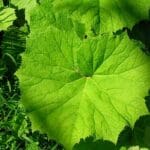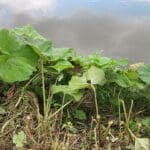Butterbur / Spring / Summer / Edible
Common Names
Rain Hat, Petasites, Purple Butterbur, Bog Rhubarb, Pestilence Wort, Plague Root, Edlin, Devil’s Hat and Butterfly-dock, Fuki (Japan).
Botanical Name
Petasites Hybridus
Scientific Classification
Kingdom – Plantae
Order – Asterales
Family – Asteraceae
Physical Characteristics for Butterbur
Leaves
Roughly heart shaped, with grey downy hairs on the underside with bluntly toothed edges often with a slight purple to brown hue. Very similar in appearance to that of Rhubarb, but smaller and more compact. Can grow up to 90cm in size.
Flowers
Male and female flowers are found on different plants. Flowers grow on spikes that appear before the leaves; they are small and pink-pale purple in colour arranged in a tight cluster down the stem. They are between 10-40cm in height.
Roots
Pollination can occur between male and female plants, however Butterbur spreads much more prominently through rhizomes; meaning it sends out root-like structures that can produce new plants and for large patches all growing from the same root system.
Habitat
Generally preferring shady areas, wet meadows, stream banks, road banks and woodland margins; often an escapee of old gardens.
Known Hazards
There is debate on the toxicity of this plant due to the presence of pyrrolizidine alkaloids found in this plant; This can result in liver damage.
It is suggested that you do not consume this plant in large quantities, or over a long duration and should be avoided if pregnant.
It is recommended that you do not consume any part of this plant raw, particularly the root.
As an occasional treat they should cause no problem. However they should always always be boiled and soaked before consumption as all members of the family contain bitter tasting, slow acting liver toxins called pyrrolizidine alkaloids.
Please don’t let this panic you. These compounds are found in over 6,000 different plant species as well as many dairy and meat products, as with everything just use it in moderation!
Could be Confused with
Different sub species of Butterbur such as White and Giant Butterbur; easily distinguished by flower colour and size (as you might guess). No further concerns, they are still usable in a similar way.
Coltsfoot (Tussilago Farfara) this has a similar leaf shape but has much more pointed edges and nowhere near as large
Edible Uses
Flowers/Stems
Used commonly in Japan, referred to as ‘Fuki no to’; Before flowering the buds and young stalks and buds are used as an aromatic vegetable and are a delicacy. They can be boiled for between 4-6 minutes and blanched. They can then be tempura battered and fried as well as chopped and stirred into Miso; They have a unique aroma with sweet and herby notes.
Leaves
Generally considered too tough and unpalatable when older, however when young the stalks can be used as a Rhubarb alternative. Young leaves can also be sautéed, pickled, put into soups and even used as a filling for Asian style dumplings.
As an occasional treat they should cause no problem. However they should always always be boiled and soaked before consumption as all members of the family contain bitter tasting, slow acting liver toxins called pyrrolizidine alkaloids.
Please don’t let this panic you. These compounds are found in over 6,000 different plant species as well as many dairy and meat products, as with everything just use it in moderation!
Notes on Herbal Uses
In traditional medicine Butterbur has been used to treat fevers, coughs, asthma, wounds, urinary tract inflammation, and stomach ailments.
However there is insufficient evidence to suggest it helps with these particular ailments. The extract from the root of this plant has been used for centuries across the globe to help fight migraines, hay fever and as an antioxidant.
It is readily available in a wide array of health stores and websites.
Extra notes from the Foragers
Butterbur is named after its alleged use for wrapping and preserving butter in warmer weather as its leaves are large and pliable. In many languages it is referred to as rain hat for its large waterproof leaves being used as a hood in rainy weather.
All throughout Europe the root of the Plant was used as a common treatment for the Plague and pestilence; known for its pungent smell it was burned and smelt to ‘smoke it out’ and even crushed and put into wine to be drunk! (I doubt it worked but it probably didn’t actually make it worse).
The seeds even have history of being used in love divination rituals in the UK:
“The seeds of butterdock must be sowed by a young unmarried woman half-an-hour before sunrise on a Friday morning, in a lonesome place. She must strew the seeds gradually on the grass, saying these words:
I sow, I sow!
Then, my own dear,
Come here, come here,
And mow and mow!
The seed being scattered, she will see her future husband mowing with a scythe at a short distance from her. She must not be frightened, for if she says, ‘Have mercy on me’, he will immediately vanish!
This method is said to be infallible, but it is looked upon as a bold, desperate, and presumptuous undertaking!”
It is worth stating the importance of this plant, in some areas it can become fairly invasive. It is, however, of vital importance to the local bee population. White butterbur was introduced in the 1600s as an ornamental species and tends to spread much more prolifically.
References
https://inlanding.wordpress.com/2013/09/17/butterbur/
https://botanical.com/botanical/mgmh/b/butbur96.html
https://www.nccih.nih.gov/health/butterbur
https://scotlandsnature.wordpress.com/2016/03/16/species-of-the-month-the-butterbur/
https://www.naturespot.org/species/butterbur
https://luontoportti.com/en/t/1355/common-butterbur
https://www.gardenista.com/posts/fuki-miso-early-spring-recipe/
https://www.webmd.com/vitamins/ai/ingredientmono-649/butterbur












